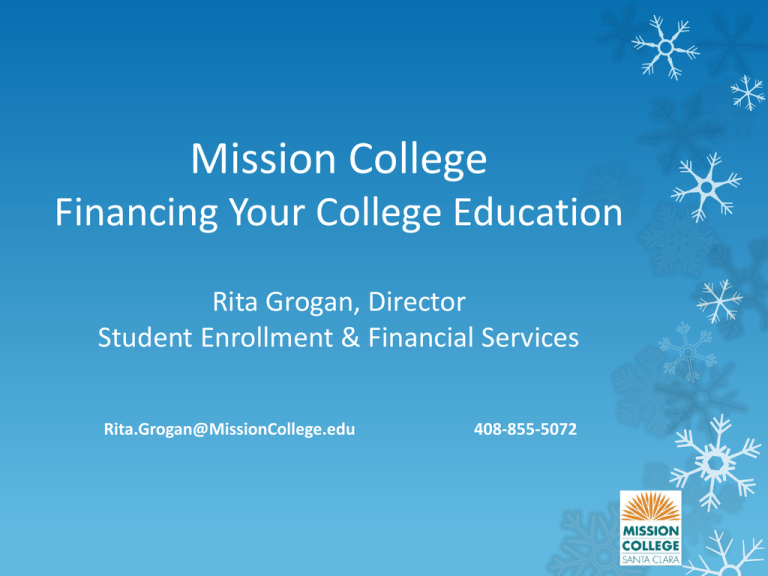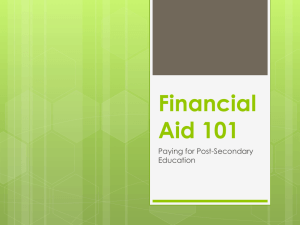Types of Financial Aid
advertisement

Mission College Financing Your College Education Rita Grogan, Director Student Enrollment & Financial Services Rita.Grogan@MissionCollege.edu 408-855-5072 What You’ll Learn Today Planning for college Types of financial aid Gift aid Self-help aid Application process FAFSA California Dream Act CSS Financial Aid PROFILE Calculating your eligibility Cost of attendance Awarding & packaging What’s next? What we should have done! $100 per month to each child’s college savings account AT BIRTH! (In some cases, we should have started before birth!) WHY? Parents have the first responsibility to provide for their dependent child’s educational costs. Don’t “should” on yourself! Life happens and we don’t always get to what we “should” have done or hoped to do! Commitment to high-quality educational choices at the K-12 level are made that impact our ability to save! Time “slips” by faster than we thought it could! (It happens to those of us who are financial aid professionals, too!) What now? Maybe I didn’t plan enough. • What can my child look forward to now for college costs payment options? • What can I afford? Financial Aid - Sources Federal government State agency/government Colleges and universities Private agencies, companies, foundations and parents’ employers Financial Aid - Categories Gift Aid Grants: Free money! Scholarships: money! Self-help Aid Work-study: part- time job Free Loans: back Financial Aid is any money given, paid or loaned to help pay for education. must be paid Types of Financial Aid – Gift Aid Federal Grants: Federal Pell Grant up to $5,645 a year Federal Supplemental Educational Opportunity Grant up to $4,000 a year Federal TEACH Grant up to $4,000 a year Iraq & Afghanistan Service Grant up to $5,645 Types of Financial Aid – Gift Aid California State Grants: Cal Grant A Entitlement Awards (fees and tuition) CSU: $5,472 UC: $12,192 Private college: $9,084 Cal Grant B Entitlement Awards (+living allowance) $1,473 first year; $1473 + [up to] $12,192 2nd yr+ CC=$1,473 Cal Grant A & B Transfer Entitlement (CCC to 4-yr.) up to $12,192 Cal Grant C Awards (career technical programs) Up to $2,462 CC=$547 Cal Grant A Competitive Awards Minimum 3.0 GPA Cal Grant B Competitive Awards Minimum 2.0 GPA Types of Financial Aid – Gift Aid Middle Class Scholarship New for 2014-15 For new, continuing and transfer undergraduates Attend or plan to attend a UC or CSU campus Be a U.S. citizen, permanent resident or AB540 status Maintain 2.0 GPA Family incomes up to $150, 000 Apply as of 1/1/2014 by either completing the FAFSA or Cal Dream Act Application New: Middle Class Scholarship For the 14/15, 15/16, and 16/17 school years the MCS amount is 2014-15 CSU maximum is approximately $766 and for the UC $1,700 When fully implemented in 2017-18 the maximum award will be 40% of systemwide tuition fees at a UC or CSU Types of Financial Aid – Gift Aid Fee & Tuition Waivers Community College - Board of Governor’s Fee Waiver (BOG) Waives enrollment fees, FAFSA may be required www.icanaffordcollege.com CSU State University Grant (SUG) Amounts vary, FAFSA is required www.calstate.edu or csumentor.edu UC Grant Amounts and application process vary www.universityofcalifornia.edu Independent College Grants Amounts and application process vary www.aiccu.edu or www.aiccumentor.org Financial Aid for Specific Populations ● Middle Class Scholarship, new for 2014-15: www.csac.ca.gov ● Foster Youth: Chafee Grant ~ up to $5000: www.chafee.csac.ca.gov ● Athletes: www.ncaaclearinghouse.net ● Students with dependents: EOP&S/CARE and CalWORKs ● Students with disabilities: www.heath.gwu.edu ● Military and their dependents: www.gibill.va.gov ● AB540 Students: California Dream Act www.caldreamact.org ● Early Childhood Education/Child Development: www.csac.ca.gov ● Teachers: Cal Grant A & B Extended Benefits: www.calgrants.org in addition to grants, Loan Forgiveness: www.teachforamerica.org ● Health Occupations-Scholarships & Loan Repayment: www.healthprofessions.ca.gov Types of Financial Aid – Gift Aid Institutional and Private Grants & Scholarships Provider decides on Awarding criteria Application deadline Forms or applications Awards may be Merit-based (academic performance-GPA) Need-based (financial need) Combination of the two Scholarships APPLY! . . . APPLY! . . . APPLY! No excuses . . . There is a lot of money available that goes unclaimed Scholarship Tips: Create a Resume Get active in the community: Clubs Community Service Document your community service Preview – Write – Review your essays Finish the application and turn it in on time Types of Financial Aid – Self-Help Federal Work Study Campus-based aid Must be earned through work Job may be on or off campus (~18 hrs./wk) Undergraduate and graduate students No annual maximum (~$2,000 - $3,500) Funding levels vary at each institution Need-based Types of Financial Aid – Self-Help Loans: Federal Perkins Loan School serves as lender William D. Ford Federal Direct Loan Program Money comes from U.S. Dept. of Education Private Loans (also known as ‘alternative’ loans) Money comes from lending institutions (banks) Types of Financial Aid – Self-Help Direct Loan (DL) Program Includes: Subsidized Stafford Loan (Need-based) Unsubsidized Stafford Loan (Not Need-based) PLUS Loan (Parent Loan for Undergraduate Student) Annual and aggregate loan limits apply 6-month grace period General Eligibility Criteria Status U.S citizen, permanent resident or meet AB540 criteria Valid Social Security number (Parents do not need a SS#) For CalDreamAct, no SS# is required for student or parent Males between ages 18-25 registered for Selective Service Received HS Diploma or equivalent: GED, CHSPE, Homeschooled Enrollment BOG Fee Waiver & Pell Grant will pay as low as ½ unit FSEOG, FWS, DL, Chafee & Cal Grants and loans require at least halftime status EOP&S requires full time status (with exceptions) Must be enrolled in an eligible program of study Satisfactory Academic Progress Must complete 2/3 of units attempted cumulatively Must maintain a 2.0 ‘C’ GPA Application Process Applying for Aid When applying to an institution, a student should ask the following: What forms does the institution require? In addition to the FAFSA, does the school require the completion of an institutional form? For example, CSS Profile What are the filing deadlines for each form? What type of deadline? FAFSA on the Web’s Homepage www.fafsa.gov California Dream Act www.caldreamact.org Dependency Status -FAFSA If students are NOT able to check any of the boxes below, parents income and asset information will be required to complete the FAFSA process. The above was from the 13-14 application so the “born before” date will be updated on the 2014-15 application. Questions About Assets Information for Students & Parents www.studentaid.ed.gov CSS Financial Aid PROFILE https://profileonline.collegeboard.com CSS Financial Aid PROFILE Registration Guide No paper registration form 3 step process $25 initial application & one college report $16/add’l college CSS Financial Aid PROFILE Not used for awarding federal financial aid May be filed earlier than the FAFSA – typically October of the Senior year Not all schools require (California Public Colleges don’t use) Assistance is available E-mail: help@cssprofile.org https://www.profileonline.collegeboard.com/ Timeline of Financial Aid Application Forms CSS/ Financial Aid Profile As early as October 1st of the senior year Free Application for Federal Student Aid . . . FAFSA on the Web (FOTW) Beginning January 1st of the senior year Cal Grant GPA Verification Form By March 2nd of the senior year Calculating Financial Aid Eligibility Cost of Attendance* / Allowances Standard Allowable Costs: Tuition and fees: $ 1,358 Room and board: $ 4,518 Books and supplies: $ 2,460 Transportation: $ 1,179 Misc. personal: $ 3,096 Additional Allowable Costs: Dependent care Study-abroad Disability-related Employment expenses for Total standard allowance: $12,611 (based on 13-14 ‘with parent’ COA) (13-14 ‘off campus’ COA $19,253) co-op study Student loan fees *Costs shown are CA community college average expenses. Calculating Financial Aid Eligibility Expected Family Contribution (EFC) What Is It? Need analysis is the formula used in determining a family’s EFC EFC is the measure of a family’s financial strength What is in the calculation of Expected Family Contribution generated from the FAFSA?: Number in household size Adjusted gross income Number of dependents in college Age of the older parent Assets other than the family home Calculating Financial Aid Eligibility Expected Family Contribution (EFC) Federal EFC will be same at all schools Federal financial aid eligibility varies based on institution’s Cost Of Attendance Some schools may use institutional methodology (ex, Profile calculations) to award their own institutional funds Cost of Attendance* w/parents off-campus on-campus Comm. Coll.(CC) $12,611 $19,253 n/a Cal.State Univ.(CSU) $16,442 $24,642 $24,223 Univ. of Cal. (UC) $24,092 $28,858 $33,320 Private (SCU,USC) $52,725 $59,367 $59,655 *Costs may not be actual Calculating Financial Aid Eligibility Basic Equation of Need (Eligibility) Cost of Attendance (COA) Expected Family Contribution (EFC) Eligibility for Need-based Aid Awarding & Packaging Federal awarding guidelines Pell Grant is awarded first External Scholarships or Grants Campus-based aid awarded in any order school chooses Subsidized Stafford loan eligibility is calculated before unsubsidized BUT - Institutions have different awarding policies Sample Financial Aid Package Full-time Enrollment Pell Grant $5,645 SEOG $ 500 Cal Grant B $1,473 Work Study $2,000 Scholarship $2,000 Loan $3,500 Special Circumstances Adjustments may be made to information on a case-by-case basis AFTER you file your FAFSA Special circumstances may include changes to Dependency status Income and assets Child support Number in household or college Private elementary/secondary tuition Medical or dental expenses (not covered by insurance) Quick Tips & What’s Next? You must apply/re-apply for financial aid every year Review your application results for questions, assumptions, any action required Check student portal for additional documents requested Missing documents or clarification needed Universities will start packaging late in March, early April Compare award offers Community Colleges typically package over summer months Check Cal Grant status at www.csac.ca.gov Click on “WebGrants for Students” Apply for scholarships: colleges, community organizations, etc. Parents: File taxes early; use IRS Link on FAFSA Delay of filing taxes can jeopardize best award offer EFC Calculators www.finaid.org Click on Calculators Click on Expected Family Contribution and Financial Aid Calculator www.fafsa4caster.ed.gov Will need a to create a password www.Collegeboard.com Under “For Parents”, click on Pay for College Click on Financial Aid Easy Planner Estimate your Share Resources www.icanaffordcollege.com www.studentaid.ed.gov www.federalstudentaid.gov www.csac.ca.gov www.calgrants.org www.caldreamact.org www.collegeboard.com www.going2college.org www.roybal-allard.house.gov/Students www.maldef.org Thank you! Questions?




